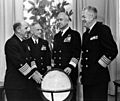John S. McCain, Jr. facts for kids
Quick facts for kids
Jack McCain
|
|
|---|---|

Admiral John Sidney McCain, Jr.
|
|
| Nickname(s) | Jack |
| Born | January 17, 1911 Council Bluffs, Iowa, U.S. |
| Died | March 22, 1981 (aged 70) In air over North Atlantic |
| Buried | |
| Allegiance | |
| Service/ |
|
| Years of service | 1931-1972 |
| Rank | |
| Unit | retirement in 1972 |
| Commands held | USS Gunnel (SS-253) USS Dentuda (SS-335) Amphibious Forces, Atlantic Fleet Eastern Sea Frontier Atlantic Reserve Fleet U.S. Naval Forces Europe U.S. Pacific Command |
| Battles/wars | World War II Korean War Vietnam War |
| Awards | Navy Distinguished Service Medal (2) Silver Star Legion of Merit (3) Bronze Star |
| Relations | Adm. John S. McCain, Sr. (father) Sen. John S. McCain III (son) |
John Sidney "Jack" McCain Jr. (born January 17, 1911 – died March 22, 1981) was a very important U.S. Navy admiral. He served in many big conflicts from the 1940s to the 1970s. He was even in charge of all U.S. forces in the Pacific Ocean as the Commander of the U.S. Pacific Command.
McCain grew up in Washington, D.C.. He graduated from the U.S. Naval Academy in 1931. After that, he joined the submarine service. During World War II, he commanded submarines. He helped sink several Japanese ships. For his bravery, he received the Silver Star and Bronze Star medals.
After the war, he led different naval groups. He became an expert in amphibious warfare, which means landing troops from the sea onto land. He led the U.S. forces during the 1965 action in the Dominican Republic. He also worked in Washington, D.C. He was known for being strongly against communism. People called him "Mr. Seapower" because he always pushed for a strong navy.
Contents
Leading Forces in the Vietnam War
During the Vietnam War, Admiral McCain was the Commander-in-Chief, Pacific Command (CINCPAC). He was in charge of all U.S. forces in the Vietnam area from 1968 to 1972. He strongly supported President Richard Nixon's plan called Vietnamization. This plan aimed to have South Vietnamese forces take over more of the fighting.
McCain also played a role in U.S. actions in Cambodia. He helped convince President Nixon to launch the 1970 Cambodian Incursion. He also had a good relationship with the Cambodian leader, Lon Nol.
A Family of Admirals
Admiral McCain came from a family of naval heroes. His father, John S. McCain Sr., was also a Navy admiral. They were the first father-son pair to both become four-star admirals.
His son, John S. McCain III, was also a naval aviator. He was a prisoner of war in North Vietnam. This happened while his father was leading U.S. forces in the region. John S. McCain III later became a U.S. Senator. He was also a candidate for President of the United States in 2008.
McCain's grandson, John S. "Jack" McCain IV, also graduated from the United States Naval Academy in 2009. He became a Naval Aviator like his father and great-grandfather. This means four generations of John S. McCains served in the Navy.
Retirement and Death
Admiral McCain retired from the Navy on November 1, 1972. In early 1973, his son was released as a prisoner of war. This happened after the Paris Peace Accords were signed.
McCain visited the White House in 1975. He talked with President Gerald Ford about how ready the Navy was. In the late 1970s, he sometimes advised Ronald Reagan on military matters. Reagan was preparing to run for president.
Admiral McCain died from a heart attack on March 22, 1981. He was on a military plane flying from Europe. His wife was with him. He was buried at Arlington National Cemetery on March 27, 1981.
Images for kids
-
"Jack" McCain alongside his father, Admiral John S. "Slew" McCain Sr., on board a U.S. Navy ship in Tokyo Bay, September 2, 1945.
See also
 In Spanish: John S. McCain, Jr. para niños
In Spanish: John S. McCain, Jr. para niños







